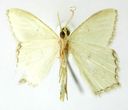Nemoria
Nemoria
Classification
- Phylum: Arthropoda
- Subphylum: Hexapoda
- Class: Insecta
- Order: Lepidoptera
- Superfamily: Geometroidea
- Family: Geometridae
- Subfamily: Geometrinae
- Tribe: Nemoriini
- Genus: Nemoria
Pronunciation
How to pronounce Nemoria: //nɛˈmɔːriə//
These audio files are automatically generated. While they are not always 100% accurate, they are a good starting point.
Images






Summary
Nemoria is a genus of emerald moths in the family Geometridae, characterized by their striking green coloration and distinct wing structure. They inhabit wooded areas where their larvae feed on various woody plants.
Physical Characteristics
Medium-sized moths with rounded to angular wings; typically striking green color with red and iridescent highlights; faint white lines on wings. Adult moths typically range from 20 to 30 mm in wingspan.
Identification Tips
Look for the characteristic green coloration and the rounded shape of the hindwings. The presence of faint white lines across the wings can also be a distinguishing feature.
Habitat
Forests and wooded areas, where larvae can feed on the foliage of various woody plants.
Distribution
Primarily found in North America, with about 38 species described.
Diet
Larvae feed on the foliage of various woody plants.
Life Cycle
Includes a larval stage where they are caterpillars feeding on host plants, followed by pupation and emergence as adult moths.
Reproduction
Details about the reproductive habits of Nemoria are limited, but generally involve laying eggs on the host plants where the larvae will feed.
Predators
Natural predators may include birds, other insects, and small mammals that feed on moths and their larvae.
Ecosystem Role
Play an ecological role as herbivores during their larval stage and as prey for various predators in the ecosystem.
Collecting Methods
- Light trapping
- Netting adults during the day or at dusk
Preservation Methods
- Pinning
- Setting in display boxes
Evolution
The genus Nemoria is part of the subfamily Geometrinae, which is characterized by its unique wing structure and morphology.
Similar Taxa
- Other genera in the Geometridae family
- Related emerald moth genera
Misconceptions
Emerald moths are often confused with other green-colored moths and butterflies due to their similar appearance, although they belong to different families.
Tags
- moths
- Geometridae
- emerald moths
- Lepidoptera
- insects